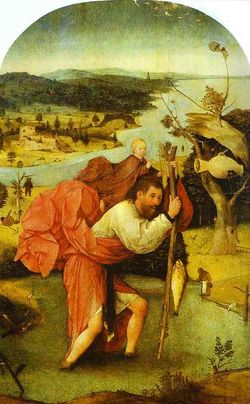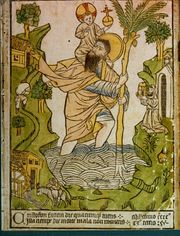Saint Christopher
| Saint Christopher | |
|---|---|
 St. Christopher Carrying the Christ Child, by Hieronymus Bosch (c. 1485) |
|
| Martyr | |
| Born | Canaan (Western accounts) or Marmarica (Eastern accounts) |
| Died | c. 251 Asia Minor |
| Venerated in | Anglicanism Eastern Orthodoxy Lutheranism Oriental Orthodoxy Roman Catholicism |
| Feast | 25 July (West), 9 May (East) |
| Attributes | tree, branch, as a giant or ogre, carrying Jesus, spear, shield, as a dog-headed man |
| Patronage | bachelors, transportation (drivers, sailors, etc.), travelling (especially for long journeys), storms, Brunswick, Saint Christopher's Island (Saint Kitts), Island Rab, Vilnius, epilepsy, gardeners, holy death, toothache |
Saint Christopher (Greek: Άγιος Χριστόφορος) is a saint venerated by Roman Catholics and Orthodox Christians, listed as a martyr killed in the reign of the 3rd century Roman emperor Decius (reigned 249–251).
The Eastern Orthodox Church venerates Saint Christopher on May 9. The Tridentine Calendar allowed a commemoration of Saint Christopher on 25 July only in private Masses. This restriction was lifted later (see General Roman Calendar as in 1954). While the Roman Catholic Church still approves devotion to him, listing him in the Roman Martyrology among the saints venerated on 25 July,[1] it removed his feast day from the Roman Catholic calendar of saints in 1969. At that time the church declared that this commemoration was not of Roman tradition, in view of the relatively late date (about 1550) and limited manner in which it was accepted into the Roman calendar.[2]
The Catholic Church suggests that almost nothing historical is known about the life and death of St. Christopher,[3] however several legends are attributed to him. The most popular variations originate from The Golden Legend, a thirteenth-century compilation of stories.
Contents |
Legend of St. Christopher
Historical examination of the legends suggests Reprobus (Christopher) lived during the Christian persecutions of either the Roman emperor Decius or Diocletian, and that he was captured and martyred by the governor of Antioch.[4] Historian David Woods has proposed that Christopher's remains were possibly taken to Alexandria by Peter of Attalia where he may have become identified with the Egyptian martyr Saint Menas.[4]

Christopher was a Canaanite 5 cubits (7.5 ft) tall and with a fearsome face. While serving the king of Canaan, he took it into his head to go and serve the greatest king there was. He went to the king who was reputed to be the greatest, but one day he saw the king cross himself at the mention of the devil. On thus learning that the king feared the devil, he departed to look for the devil. He came across a band of marauders, one of whom declared himself to be the devil, so Christopher decided to serve him. But when he saw his new master avoid a wayside cross and found out that the devil feared Christ, he left him and enquired from people where to find Christ. He met a hermit who instructed him in the Christian faith. Christopher asked him how he could serve Christ. When the hermit suggested fasting and prayer, Christopher replied that he was unable to perform that service. The hermit then suggested that because of his size and strength Christopher could serve Christ by assisting people to cross a dangerous river, where they were perishing in the attempt. The hermit promised that this service would be pleasing to Christ.
After Christopher had performed this service for some time, a little child asked him to take him across the river. During the crossing, the river became swollen and the child seemed as heavy as lead, so much that Christopher could scarcely carry him and found himself in great difficulty. When he finally reached the other side, he said to the child: "You have put me in the greatest danger. I do not think the whole world could have been as heavy on my shoulders as you were." The child replied: "You had on your shoulders not only the whole world but Him who made it. I am Christ your king, whom you are serving by this work." The child then vanished.
Christopher later visited the city of Lycia and there comforted the Christians who were being martyred. Brought before the local king, he refused to sacrifice to the pagan gods. The king tried to win him by riches and by sending two beautiful women to tempt him. Christopher converted the women to Christianity, as he had already converted thousands in the city. The king ordered him to be killed. Various attempts failed, but finally Christopher was decapitated.
Veneration and patronage
Eastern Orthodox Liturgy
The Eastern Orthodox Church venerates Christopher of Lycea with a Feast Day on May 9. The liturgical reading and hymns refer to his imprisonment by Decius who tempts Christopher with harlots before ordering his beheading.[5] The Kontakion in the Fourth Tone (hymn) reads:
"Thou who wast terrifying both in strength and in countenance, for thy Creator's sake thou didst surrender thyself willingly to them that sought thee; for thou didst persuade both them and the women that sought to arouse in thee the fire of lust, and they followed thee in the path of martyrdom. And in torments thou didst prove to be courageous. Wherefore, we have gained thee as our great protector, O great Christopher."[6]
Relics and Medals
After having been held in Constantinople, the relics and the head of the saint were moved to the island of Rab in Croatia. When Normans tried to invade the islands and besieged the city, its inhabitants placed the saint's relics on the city walls. Miraculously, the winds changed and the arrows and ships were blown away from the city. One of the city's largest medieval squares is named after the saint.
Christopher is one of the Fourteen Holy Helpers, and the patron saint of travelers. Medallions with his name and image are worn to show devotion to a certain saint and ask for that saint's prayers. They are frequently displayed in automobiles. In French a widespread phrase for such medals is "Regarde St Christophe et va-t-en rassuré" ("Look at St Christopher and go on reassured"); Saint Christopher medals and holy cards in Spanish have the phrase "Si en San Cristóbal confías, de accidente no morirás" ("If you trust St. Christopher, you won't die in an accident"). In Austria an annual collection for providing vehicles for the use of missionaries is taken up on a Sunday close to the feast of Saint Christopher, asking people to contribute a very small sum of money for every kilometre that they have traveled safely during the year.
General patronage
Christopher has always been a widely popular saint, being especially revered by athletes, mariners, ferrymen, and travelers.[7] He is revered as one of the Fourteen Holy Helpers. He holds patronage of things related to travel and travelers: against lightning; against pestilence; archers; bachelors; boatmen; bookbinders; epilepsy; floods; fruit dealers; fullers; gardeners; for a holy death; mariners; market carriers; motorists and drivers; sailors; storms; surfers[8]; toothache; and transportation workers.
Patronage of places
Christopher is the patron saint of the many places, including: Baden, Germany[7]; Barga, Italy; Brunswick, Germany[7]; Mecklenburg, Germany[7]; Rab, Croatia; Roermond, The Netherlands; Saint Christopher's Island (Saint Kitts); Toses in Catalonia, Spain; Mondim de Basto, Portugal; Agrinion, Greece; Vilnius, Lithuania; Havana, Cuba; and Paete, Laguna, Philippines.
References in popular culture
- See Saint Christopher in popular culture
Notes
- ↑ Martyrologium Romanum (Libreria Editrice Vaticana, 2001 ISBN 88-209-7210-7)
- ↑ Calendarium Romanum (Libreria Editrice Vaticana, 1969), p. 131
- ↑ "FAQ's - Saints & Angels - Catholic Online". http://www.catholic.org/saints/faq.php#St.%20Christopher. Retrieved 2008-07-13.
- ↑ 4.0 4.1 David Woods, "St. Christopher, Bishop Peter of Attalia, and the Cohors Marmaritarum: A Fresh Examination", Vigiliae Christianae, Vol. 48, No. 2 (Jun., 1994), p.170
- ↑ "Christopher the Martyr of Lycea", Saints, Greek Orthodox Archdiocese of America, 2009
- ↑ Holy Transfiguration Monastery, (translation), "Kontakion in the Fourth Tone", Saints, Greek Orthodox Archdiocese of America, 2009
- ↑ 7.0 7.1 7.2 7.3 Mershman, F. (1908). St. Christopher. In The Catholic Encyclopedia. New York: Robert Appleton Company. Retrieved September 16, 2008
- ↑ Dioces of Orange hosts First Annual Blessing of the Waves in Surf City Roman Catholic Diocese of Orange, September 15, 2008
External links
- Saint Christopher Website with information and references about St. Christopher.
- "The Life of Saint Christopher", The Golden Legend or Lives of the Saints, Temple Classics, 1931 (Compiled by Jacobus de Voragine, Translated by William Caxton) at the Fordham University Medieval Sourcebook
|
|||||